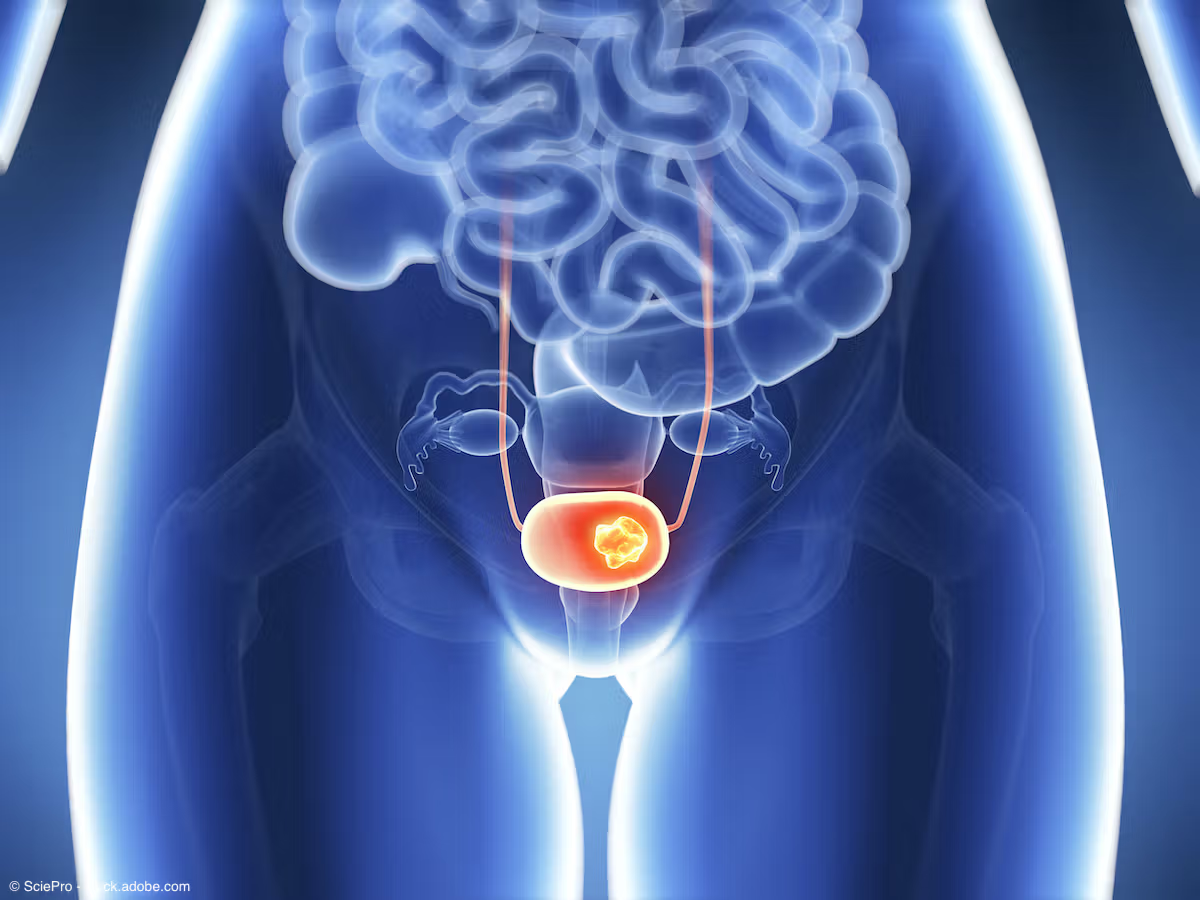Feature
Article
Perioperative outcomes support benefit of TAR-200 plus cetrelimab in MIBC
Author(s):
Key Takeaways
- SunRISe-4 evaluates TAR-200 and cetrelimab in muscle-invasive bladder cancer patients ineligible for cisplatin-based chemotherapy, showing promising pathological response rates.
- Adverse events were mostly mild and localized, with surgical safety outcomes showing no significant changes in key safety parameters.
"Provided that we will confirm the efficacy data long-term, there is an opportunity to spare, de-escalate a bit, the treatment in select patients, and to expose the patient with inferior risk of developing severe [adverse] effects," says Andrea Necchi, MD.
In the following interview, Andrea Necchi, MD, shares in-depth insights into the study, “Perioperative outcomes of neoadjuvant (neoadj) TAR-200 plus cetrelimab (CET) or CET alone in patients (pts) with muscle-invasive bladder cancer (MIBC) ineligible for or refusing neoadj cisplatin-based chemotherapy (NAC),” which was recently presented at the 40th Annual European Association of Urology (EAU) Congress in Madrid, Spain.
Necchi is a professor of medical oncology at Vita-Salute San Raffaele University and the director of GU oncology at San Raffaele Hospital in Milan, Italy.
Andrea Necchi, MD

Could you describe the background/rationale for this study? What previous data have been reported?
SunRISe-4 is part of the platform of SunRISe studies that are targeting early bladder cancer, including non–muscle invasive disease and muscle-invasive disease. In particular, SunRISe-4 is targeted to patients diagnosed with the muscle-invasive tumor, so T clinical—T2-T4a N0M0 muscle-invasive bladder cancer with pure or predominant urothelial cancer histology.
SunRISe-4 is a randomized phase 2 study evaluating TAR-200, which is a gemcitabine-releasing system into the bladder, plus cetrelimab, a checkpoint inhibitor and anti-PD-1 agent, in patients scheduled for radical cystectomy and who are also ineligible for or refuse cisplatin-based chemotherapy. [There are] 2 parallel arms: TAR-200 and cetrelimab in arm A and cetrelimab monotherapy in arm B. It's not actually a comparative study. These 2 arms are not intended to provide a formal, statistical comparison of the efficacy outcomes but are parallel arms. The design is aimed to provide a descriptive analysis of the outcomes in both arms.
In [the] interim analysis that I presented at ESMO [the European Society for Medical Oncology Congress] a few months ago, neoadjuvant TAR-200 and cetrelimab showed a higher pathological complete response (pCR) rate, as high as 42%, and pathological objective response (pOR), meaning downstaging to non–muscle invasive disease, of 62% in the ITT population. In the cetrelimab arm, these proportions were 23% and 36%. There was an enrichment in particular in pCR and pOR in patient presenting with the clinical t2 stage. Based on various secondary assessments, like, for example, the exposure to TAR-200 [of] those patients. The majority [of patients who] were able to receive the 4 doses of neoadjuvant TAR-200 benefited the most in terms of pCR from the neoadjuvant therapy.
Most of the adverse events provided at the interim analysis were grade 1 and 2 and were mostly confined to urinary events. So, nothing really major and nothing very concerning with regard to systemic [adverse events].
What were the key findings presented at EAU?
The analysis that was presented very nicely by Sarah Psutka, MD, at the EAU meeting [was] focused on the surgical safety and surgical outcomes. We are still dealing with an interim analysis subset and not the full study accrual. The patients who were evaluated were 50 patients in the combination therapy arm and 26 radical cystectomies in the cetrelimab monotherapy arm. In general, the patient characteristics were pretty much in line with those already presented with the interim analysis at the ESMO meeting.
Importantly, the main safety parameters that were represented—changes in body mass index, changes in albumin level, changes in creatinine, changes in hemoglobin level—were not significant pre- and post-therapy. Other very important safety parameters, such as the median time to radical cystectomy, were [generally] in line with the safety boundaries, being 13.6 weeks in the TAR-200/cetrelimab arm and 12.4 weeks in the cetrelimab monotherapy arm. So, the treatment was pretty much safe in both arms.
With regard to the overall grade 3 and 4 [adverse] effects, they were reported in 42% of the combination therapy arm patients and 41% in the cetrelimab monotherapy [arm patients]. Again, most of these [adverse events] were not preventing the continuation of therapy, preventing cystectomy, or exposing the patient to an extra toxicity, but were primarily confined to local [adverse events]. With regard to the distribution between robotic and open cystectomy, there was nothing major to say. The data were pretty much in line with what is happening in standard practice.
What are the next steps for this study?
The only missing point is to look at the entire dataset [to] confirm these findings with regard to efficacy and safety in the interim analysis. The study is accrued, and we are still waiting for the finalized subset, so we'll see if there will be any change. Very small changes are expected, with regard to both efficacy and safety, in my opinion.
Based on these initial findings, what is the overall take-home message for urologists?
We can target the MIBC treatment with a different modality as compared with what we were used to in the recent past. Looking at the combination of intravesical therapy and systemic therapy may provide us and may provide the patient with an opportunity of achieving sustained responses, while preserving most of the [adverse] effects that are usually provided by aggressive systemic therapy, meaning chemotherapy or maybe in the near future, an [antibody-drug conjugate] and [immunotherapy] combination.
We have a snapshot of the safety data from different approaches, such as the NIAGARA approach—the immune therapy and chemotherapy combination. The safety data from NIAGARA is in line with the chemotherapy data. So, nothing exceedingly higher than the literature. But the quality of the 40% to 45% of grade 3/4 [adverse] effects that have been reported in NIAGARA is different from the quality of [adverse events] reported in SunRISe-4, mainly being represented by systemic [adverse events]. We are shifting the landscape toward something that is maybe more manageable for the patient. Provided that we will confirm the efficacy data long-term, there is an opportunity to spare, de-escalate a bit, the treatment in select patients, and to expose the patient with inferior risk of developing severe [adverse] effects.
Is there anything else that you’d like to add?
The natural evolution for SunRISe-4, provided that there would be a validation of pathological response findings, is to fine-tune the selection of the patients, trying to select the patients for whom the pCR rate rises to above 50%, such as clinical T2 patients, or maybe [using] biomarkers. We are still waiting for biomarkers from SunRISe-4. If we're able to get this point, to overcome the 50% pCR bar in select patients from SunRISe-4, there would be an opportunity to think about bladder-sparing approaches as the next step. [We could] provide maybe an IO and then reintravesical therapy with the aim to spare the bladder in patients who respond completely at the clinical evaluation after treatment as compared to the baseline situation.













